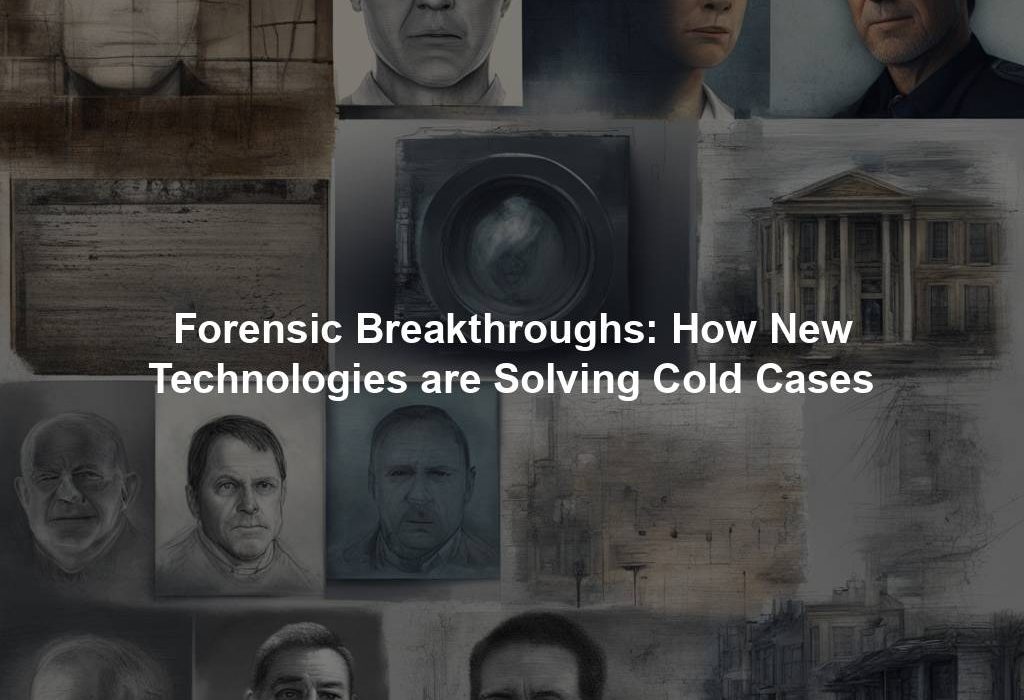In recent times, the evolution of forensic technologies has fundamentally reshaped the landscape of solving cold cases, breathing new life into investigations that seemed destined for obscurity. These cutting-edge tools have not only empowered law enforcement agencies to delve deeper into unresolved crimes but have also offered a glimmer of hope to families long haunted by unanswered questions and lingering grief.
DNA analysis stands at the forefront of this technological revolution, emerging as a formidable weapon in the arsenal of forensic scientists. Deoxyribonucleic acid, the intricate genetic blueprint inherent in every cell, serves as a poignant fingerprint that sets individuals apart. The painstaking process, once characterized by laborious efforts, has been streamlined and enhanced through technological strides, accelerating the pace and precision of identifying suspects and untangling crime scenes’ enigmatic threads.
Among the milestones in DNA analysis, rapid DNA testing shines brightly as a beacon of efficiency. In mere hours, what was once a prolonged wait spanning days or weeks can now yield results promptly. This expeditious analysis proves indispensable in cold cases, facilitating swift comparisons between DNA evidence and suspects’ genetic profiles or criminal databases, ushering in a new era of expeditious justice.
Familial DNA searching emerges as another pivotal advancement, shedding light on connections that transcend individual profiles. By scrutinizing DNA evidence for familial ties within databases, investigators can trace potential relatives of suspects who elude direct identification. This nuanced approach becomes invaluable when the suspect’s DNA remains elusive but a close relative’s genetic imprints unravel concealed truths, narrowing the investigative focus to kinship links that shape compelling narratives.
Beyond DNA’s transformative role, innovative technologies like forensic imaging have left an indelible mark in deciphering enigmatic crime scenes. Leveraging sophisticated software, forensic imaging unravels hidden details, breathing life into static images of victims, suspects, and locales. This analytical prowess unveils overlooked nuances, unfurling captivating leads and prospects that reinvigorate dormant investigations.
In tandem with forensic imaging, the realm of forensic anthropology emerges as a beacon of clarity amidst the shadows of uncertainty. Delving into the intricacies of human remains, forensic anthropologists unearth crucial insights into the deceased’s identity, age, and cause of demise. Their meticulous analysis breathes new possibilities into sifting through skeletal remains, bridging crucial gaps in identifying victims, resolving missing persons cases, and furnishing crucial evidence pivotal in unraveling criminal mysteries.
As the technological tapestry of forensic science expands, newer frontiers beckon, encapsulating disciplines like forensic entomology and forensic botany. Entomological studies of crime scene insects unveil cryptic details like the time of death and crime scene localization. Meanwhile, botanical examinations decode nature’s silent witnesses, unraveling crime scene contexts and suspect movements with botanical precision, intersecting natural elements with criminal narratives.
Amidst these groundbreaking advancements lies a poignant narrative that resonates deeply – the narrative of justice deferred but not denied. This saga found poignant expression in the unmasking of the Golden State Killer, a saga spanning four decades culminating in 2018. Through the lens of familial DNA searching, investigators wove a tapestry of connections linking distant relatives to DNA evidence, ultimately trailing Joseph James DeAngelo. The avowal of justice, belated yet resolute, unfolded as DeAngelo faced charges of heinous crimes, a testament to forensic triumphs that pierced the veil of time.
However, amid these triumphs lie poignant struggles and poignant narratives, compelling tribulations that echo voices long stifled by the weight of uncertainty and unresolved grievances. Forensic laboratories, plagued by dearth and decay, bear the brunt of underfunding and understaffing, casting shadows over the timely analysis of vital DNA samples and the resolution of pivotal evidence. To fully harness the potential of innovative forensic technologies, it is imperative to infuse resources and support into these foundational pillars, empowering agencies to navigate complex investigations with dexterity and precision.
Moreover, the voyage towards justice is veiled by the absence of standardized protocols in forensic practices, underscoring the crucial need for uniformity in analytical approaches. Despite technological leaps, the absence of consolidated guidelines poses a poignant challenge in maintaining the integrity and ethics of investigative findings. By instilling comprehensive standards in forensic methodologies, agencies can bolster the credibility of their conclusions, ensuring the sanctity of justice in resolving cold cases.
In a realm colored by triumphs and tribulations, forensic science emerges as a poignant beacon of hope, illuminating pathways to closure and unveiling the indomitable human spirit’s resilience in face of adversity. The narrative of unparalleled innovation converges with poignant emotions, unraveling mysteries and weaving tales of redemption amidst the shadows of uncertainty. As the tapestry of forensic advancements unfurls, the future brims with possibilities, beckoning a new dawn where justice reigns supreme, and unresolved narratives find closure in the comforting embrace of truth.




